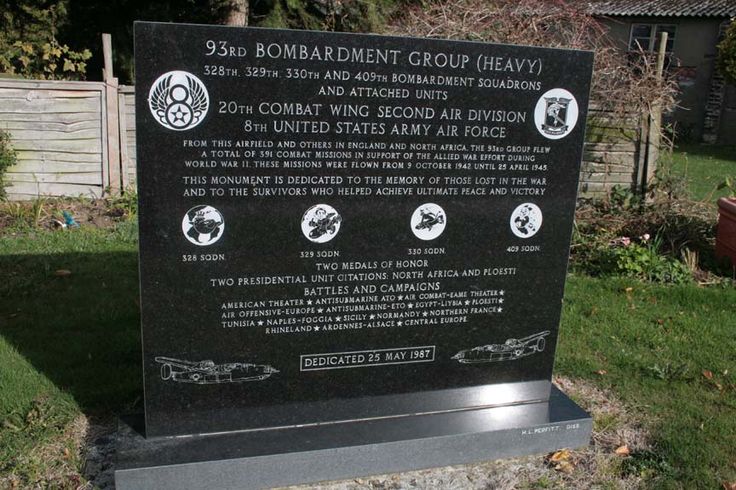93rd Bomber Group Memorial
Details:
Near wartime buildings on the east edge of the old airfield.
A free-standing, black, marble slab inscribed with a dedication message in English in white lettering. The depicted image on the top-left corner is the 8th Air Force insignia while on the top-right is the 93rd BG insignia. Along in the center of the memorial are the depiction of the 328th, 329th, 330th, and 409th Bomber Squadron insignias. On the bottom corners are the etchings of a B-24 Liberator bomber.
The VIII Bomber Command 93rd Bombardment Group (Heavy) arrived at Hardwick from RAF Alconbury in December 1942. The group was assigned to the 20th Combat Bombardment Wing and the group tail code was a "Circle-B". Its operational squadrons were:
- 328th Bombardment Squadron (GO)
- 329th Bombardment Squadron (RE)
- 330th Bombardment Squadron (AG)
- 409th Bombardment Squadron (YM)
The 93rd flew the Consolidated B-24 Liberator as part of the Eighth Air Force's strategic bombing campaign. The group entered combat on 9 October 1942 by attacking steel and engineering works at Lille. Until December 1942, the group operated primarily against submarine pens in the Bay of Biscay.
A large detachment was sent to North Africa in December 1942, the group receiving a Distinguished Unit Citation for operations in that theatre, December 1942 - February 1943, when, with inadequate supplies and under the most difficult desert conditions, the detachment struck heavy blows at enemy shipping and communications.
The detachment returned to England in February 1943 and until the end of June, the group bombed engine repair works, harbors, power plants, and other targets in France, the Low Countries, and Germany.
A detachment returned to the Mediterranean theatre during June and July 1943 to support the Allied invasion of Sicily and to participate in the famous low-level attack on enemy oil installations at Ploesti on 1 August. Having followed another element of the formation along the wrong course to Ploesti, the 93rd hit targets that had been assigned to other groups, but it carried out its bombing of the vital oil installations despite heavy losses inflicted by attacks from the fully alerted enemy and was awarded a Distinguished Unit Citation for the operation.
After the detachment returned to England in August 1943, the group flew only two missions before the detachment was sent back to the Mediterranean to support the Fifth Army at Salerno during the invasion of Italy in September 1943.
The detachment rejoined the group in October 1943, and until April 1945 the 93rd concentrated on the bombardment of strategic targets such as marshaling yards, aircraft factories, oil refineries, chemical plants, and cities in Germany. In addition, it bombed gun emplacements, choke points, and bridges near Cherbourg during the Normandy invasion in June 1944. It attacked troop concentrations in northern France during the Saint-Lô breakthrough in July 1944; transported food, gasoline, water, and other supplies to the Allies advancing across France, August - September 1944; dropped supplies to airborne troops in the Netherlands on 18 September 1944; struck enemy transportation and other targets during the Battle of the Bulge, December 1944 - January 1945; and flew two missions on 24 March 1945 during the airborne assault across the Rhine, dropping supplies to troops near Wesel and bombing a night-fighter base at Stormede.
The 93rd Bomb Group ceased combat operations in April 1945 and returned to Sioux Falls AAF South Dakota during May/June.
The airfield has long since been returned to agriculture and only part of one runway still remains. The main buildings such as the control tower are long gone but on the surrounding farms, a number of dispersed buildings are still in (farm) use.
Source of information: www.warmemorialsonline.org.uk, Imperial War Museum War Memorials Register, en.wikipedia.org, www.geograph.org.uk
Source of photo: pinterest.es
Monument Text:
93RD BOMBARDMENT GROUP (HEAVY)
328TH. 329TH. 330TH AND 409TH BOMBARDMENT SQUADRONS
AND ATTACHED UNITS
20TH COMBAT WING SECOND AIR DIVISION
8TH UNITED STATES ARMY AIR FORCE
FROM THIS AIRFIELD AND OTHERS IN ENGLAND AND NORTH AFRICA. THE 93RD GROUP FLEW A TOTAL OF 391 COMBAT MISSIONS IN SUPPORT OF THE ALLIED WAR EFFORT DURING WORLD WAR II. THESE MISSIONS WERE FLOWN FROM 9 OCTOBER 1942 UNTIL APRIL 1945.
THIS MONUMENT IS DEDICATED TO THE MEMORY OF THOSE LOST IN THE WAR AND TO THE SURVIVORS WHO HELPED ACHIEVE ULTIMATE PEACE AND VICTORY.
|
328 SQDN |
329 SQDN |
330 SQDN |
409 SQDN |
TWO MEDALS OF HONOR
TWO PRESIDENTAL UNIT CITATIONS: NORTH AFRICA AND PLOESTI
BATTLES AND CAMPAIGNS
AMERICAN THEATER ★ ANTISUBMARINE ATO ★ AIR COMBAT-EAME THEATER ★
AIR OFFENSIVE-EUROPE ★ ANTOSUBMARINE-ETO ★ EGYPT-LIYBIA ★ PLOESTI ★
TUNISIA ★ NAPELS-FOGGIA ★ SICILIY ★ NORMANDY ★ NORTHERN FRANCE ★
RHINELAND ★ ARDENNES-ALSACE ★ CENTRAL EUROPE.
|
DEDICATED 25 MAY 1987 |
Commemorates:
Units:
328th Bomber Squadron, 93rd Bomber Group, Heavy
329th Bomber Squadron, 93rd Bomber Group, Heavy
330th Bomber Squadron, 93rd Bomber Group
409th Bomber Squadron, 93rd Bomb Group
93rd Bomber Group
Wars:
WWII

